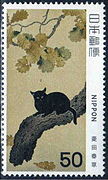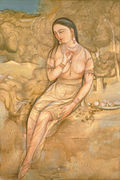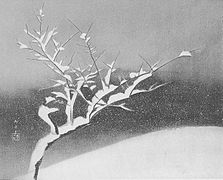Nihonga
Nihonga ( Japanese 日本 画 , German Japanese painting ) was introduced in 1890 by the American orientalist Ernest Fenollosa and the Japanese art historian Okakura Kakuzō with the aim of maintaining traditional Japanese painting in a modernized form during the time of upheaval. Opposite her was the Japanese painting of the western kind, Yōga .
Overview
The characteristics of Nihonga are:
- Avoidance of depth display, at most use of parallel perspective ,
- Renouncing shadows,
- Use of (often self-mixed) mineral paints , never oil paints.
Of course there have been and still are border crossings.
In order to tie in with traditional Japanese painting, Kanō Hōgai (1828–1888), the most important representative of the Kanō school at the time , was provided at Nihon Bijutsu Gakkō, founded in 1879 . Due to his early death then his student Hashimoto Gahō (1835-1908) took over the chair. His early students include Yokoyama Taikan (1868-1958), Shimomura Kanzan (1873-1930) and Hishida Shunsō (1874-1911). Next are Kaburagi Kiyokata (1878-1972), Kobayashi Kokai (1883-1957), Yasuda Yukihiko (1884-1978), Maeda Seison (1885-1977) and Hayami Gyoshū to name (from 1884 to 1935). All of the above have been awarded the Bunkakunshō , the highest state award in the field of culture.
In Kyōto a separate, freer direction of Nihonga developed with Takeuchi Seihō (1864–1942), the painter Uemura Shōen (1875–1949) - both awarded the Bunkakunshō - and Tsuchida Bakusen (1887–1936), Murakami Kagaku (1888–1949) 1936).
The Nihonga painters were also noticed abroad. In the USA they were successful through the mediation of the art patron Isabella Stewart Gardner in Boston. In 1930 a large exhibition took place in Rome, sponsored by Baron Ōtani. In 1931 there was also a much-noticed exhibition in Berlin. Some of the pictures exhibited there, u. a. Hayami's “Nocturnal Snow” can now be found in the Museum of Asian Art in Berlin-Dahlem. Most recently, in the exhibition “Japan and Europe 1542-1929” in 1993 in the Martin-Gropius-Bau (Berlin), representatives of Nihonga painting from the 1920s were on display.
The self-classification as Nihonga or Yoga painter still happens today, but no longer with the former exclusivity. Nihonga painting has also expanded its range of subjects, even if the beauty of nature is still the focus. The moderate image content should contribute to Nihonga, e.g. B. Higashiyama Kaii (1908-1999), known from his studies in Germany , by Sugiyama Yasushi (1909-1993) or the younger Kayama Matazō (1927-2004), achieve top prices on the market that exceed those of Yōga many times over .
photos
annotation
- ↑ General directories of Japanese painters, sculptors and calligraphers, such as the annually published "Bijutsu nenkan" or "Bijutsu shijō", indicate the average price for a go (slightly larger than A3) area of their pictures for all painters .
literature
- Margit Brehm: The Japanese Experience - Inevitable . Hatje Cantz Verlag, 2002, ISBN 3-7757-1254-2 .
- Emi Akamatsu: Japanese flower painting . Knaur, Munich 2005, ISBN 978-3-426-64191-0 .
- Setsuko Kagitani: Kagitani Setsuko Hanagashû - Flowers . Tohōshuppan, Tokyo, ISBN 978-4-88591-852-0 .
- Michiaki Kawakita: Modern Currents in Japanese Art . Weatherhill / Heibonsha 1974, ISBN 0-8348-1028-X .
- Catalog Exhibition of works by living Japanese painters in the Prussian Academy of the Arts Berlin. Berlin 1931.









